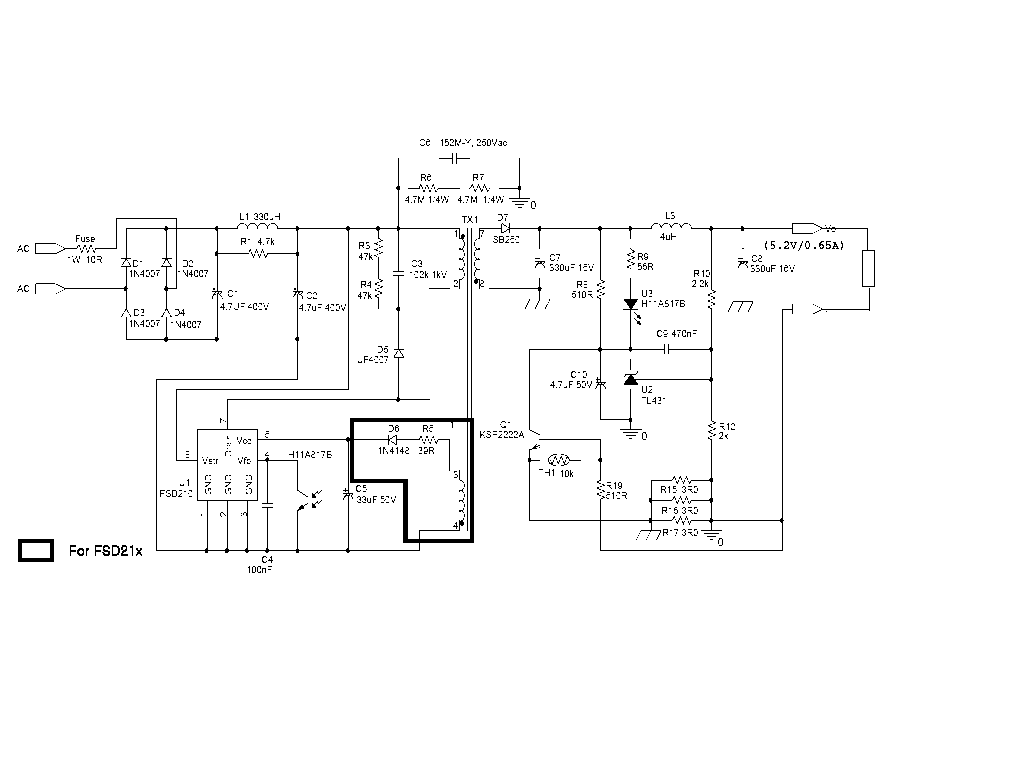1、恒流行:電流恒定不變,電壓下降
2、回卷型:初始電流恒定不變,電壓下降到一定數(shù)值電流開始減小.
3、限功率型:限定輸出的總功率
4、打隔型:過流后,電流電壓下降到0,然后又開始上升,周而復始.
5:復合型:將多種保護符合起來.
我所知道的就這些,希望大家討論各種方式以及實現(xiàn)的方法和使用的場合.
過流保護的幾種方式
全部回復(98)
正序查看
倒序查看
@
每人李,自己定一下!其實恒流有很多的實現(xiàn)方法方式,我選用的是拉低基準的方法,可恒好的控制穩(wěn)流精度,能過達到0.5%.但是有很多色問題要注意1、布線,地線一定盡量沒有干擾2、采樣基準,一定要穩(wěn)定3、環(huán)路的速度盡量的慢
恒流保護一般應用在電池充電的時候,很多系統(tǒng)對電池充電的電流要求十分嚴格,所以必須把恒流的模式做好.采樣方式可以選擇電阻線(分流器)或者霍爾,總體來說,分流器的穩(wěn)流精度高可達到0.5%,但是容易受干擾.霍爾穩(wěn)流精度會受到限制1%,但是不容易受到干擾.
0
回復
@shandongtao
恒壓式比較好!在有負載時
我看到這樣一個資料,其中關于電流限制這方面的電路沒有弄清楚.
Key Design Notes
• The constant voltage (CV) mode control is implemented with resistors, R8, R9, R10 and R11, shunt regulator, U2, feedback
capacitor, C9 and opto-coupler, U3.
• The constant current (CC) mode control is designed with resistors, R8, R9, R15, R16, R17 and R19, NPN transistor, Q1 and
NTC, TH1. When the voltage across current sensing resistors, R15,R16 and R17 is 0.7V, the NPN transistor turns on and the
current through the opto coupler LED increases. This reduces the feedback voltage and duty ratio. Therefore, the output
voltage decreases and the output current is regulated.
• The NTC(negative thermal coefficient) is used to compensate the temperature characteristics of the transistor Q1.
它是如何來控制電流的呢
 500) {this.resized=true; this.width=500; this.alt='這是一張縮略圖,點擊可放大。\n按住CTRL,滾動鼠標滾輪可自由縮放';this.style.cursor='hand'}" onclick="if(!this.resized) {return true;} else {window.open('http://u.dianyuan.com/bbs/u/26/1107398247.gif');}" onmousewheel="return imgzoom(this);">
500) {this.resized=true; this.width=500; this.alt='這是一張縮略圖,點擊可放大。\n按住CTRL,滾動鼠標滾輪可自由縮放';this.style.cursor='hand'}" onclick="if(!this.resized) {return true;} else {window.open('http://u.dianyuan.com/bbs/u/26/1107398247.gif');}" onmousewheel="return imgzoom(this);">
Key Design Notes
• The constant voltage (CV) mode control is implemented with resistors, R8, R9, R10 and R11, shunt regulator, U2, feedback
capacitor, C9 and opto-coupler, U3.
• The constant current (CC) mode control is designed with resistors, R8, R9, R15, R16, R17 and R19, NPN transistor, Q1 and
NTC, TH1. When the voltage across current sensing resistors, R15,R16 and R17 is 0.7V, the NPN transistor turns on and the
current through the opto coupler LED increases. This reduces the feedback voltage and duty ratio. Therefore, the output
voltage decreases and the output current is regulated.
• The NTC(negative thermal coefficient) is used to compensate the temperature characteristics of the transistor Q1.
它是如何來控制電流的呢
 500) {this.resized=true; this.width=500; this.alt='這是一張縮略圖,點擊可放大。\n按住CTRL,滾動鼠標滾輪可自由縮放';this.style.cursor='hand'}" onclick="if(!this.resized) {return true;} else {window.open('http://u.dianyuan.com/bbs/u/26/1107398247.gif');}" onmousewheel="return imgzoom(this);">
500) {this.resized=true; this.width=500; this.alt='這是一張縮略圖,點擊可放大。\n按住CTRL,滾動鼠標滾輪可自由縮放';this.style.cursor='hand'}" onclick="if(!this.resized) {return true;} else {window.open('http://u.dianyuan.com/bbs/u/26/1107398247.gif');}" onmousewheel="return imgzoom(this);"> 0
回復
@jiurl
我看到這樣一個資料,其中關于電流限制這方面的電路沒有弄清楚.KeyDesignNotes•Theconstantvoltage(CV)modecontrolisimplementedwithresistors,R8,R9,R10andR11,shuntregulator,U2,feedbackcapacitor,C9andopto-coupler,U3.•Theconstantcurrent(CC)modecontrolisdesignedwithresistors,R8,R9,R15,R16,R17andR19,NPNtransistor,Q1andNTC,TH1.Whenthevoltageacrosscurrentsensingresistors,R15,R16andR17is0.7V,theNPNtransistorturnsonandthecurrentthroughtheoptocouplerLEDincreases.Thisreducesthefeedbackvoltageanddutyratio.Therefore,theoutputvoltagedecreasesandtheoutputcurrentisregulated.•TheNTC(negativethermalcoefficient)isusedtocompensatethetemperaturecharacteristicsofthetransistorQ1.它是如何來控制電流的呢[圖片]500){this.resized=true;this.width=500;this.alt='這是一張縮略圖,點擊可放大。\n按住CTRL,滾動鼠標滾輪可自由縮放';this.style.cursor='hand'}"onclick="if(!this.resized){returntrue;}else{window.open('http://u.dianyuan.com/bbs/u/26/1107398247.gif');}"onmousewheel="returnimgzoom(this);">
我不是十分熟悉你這個芯片,我理解是這樣的:
1、輸出電流增加,R15\16\17\上的壓降增加
2、造成Q1控制記得電壓增加,Q1導通
3、光偶U3導通,造成芯片的4P拉低,進入穩(wěn)流!
如有不正確,請批評!!!
1、輸出電流增加,R15\16\17\上的壓降增加
2、造成Q1控制記得電壓增加,Q1導通
3、光偶U3導通,造成芯片的4P拉低,進入穩(wěn)流!
如有不正確,請批評!!!
0
回復
@jiurl
我看到這樣一個資料,其中關于電流限制這方面的電路沒有弄清楚.KeyDesignNotes•Theconstantvoltage(CV)modecontrolisimplementedwithresistors,R8,R9,R10andR11,shuntregulator,U2,feedbackcapacitor,C9andopto-coupler,U3.•Theconstantcurrent(CC)modecontrolisdesignedwithresistors,R8,R9,R15,R16,R17andR19,NPNtransistor,Q1andNTC,TH1.Whenthevoltageacrosscurrentsensingresistors,R15,R16andR17is0.7V,theNPNtransistorturnsonandthecurrentthroughtheoptocouplerLEDincreases.Thisreducesthefeedbackvoltageanddutyratio.Therefore,theoutputvoltagedecreasesandtheoutputcurrentisregulated.•TheNTC(negativethermalcoefficient)isusedtocompensatethetemperaturecharacteristicsofthetransistorQ1.它是如何來控制電流的呢[圖片]500){this.resized=true;this.width=500;this.alt='這是一張縮略圖,點擊可放大。\n按住CTRL,滾動鼠標滾輪可自由縮放';this.style.cursor='hand'}"onclick="if(!this.resized){returntrue;}else{window.open('http://u.dianyuan.com/bbs/u/26/1107398247.gif');}"onmousewheel="returnimgzoom(this);">
R11在哪兒?
0
回復
@jiurl
基極的電壓是否通過NTC(TH1)電阻反饋得到的?Q1沒有導通就是說基極的電壓沒有達到0.7V,R15~17流過的電流不夠大,是嗎,那么這個電流回路是在那里呢.呵呵,還是有些不太明白.
看看圖P 500) {this.resized=true; this.width=500; this.alt='這是一張縮略圖,點擊可放大。\n按住CTRL,滾動鼠標滾輪可自由縮放';this.style.cursor='hand'}" onclick="if(!this.resized) {return true;} else {window.open('http://u.dianyuan.com/bbs/u/26/1107409994.gif');}" onmousewheel="return imgzoom(this);">
500) {this.resized=true; this.width=500; this.alt='這是一張縮略圖,點擊可放大。\n按住CTRL,滾動鼠標滾輪可自由縮放';this.style.cursor='hand'}" onclick="if(!this.resized) {return true;} else {window.open('http://u.dianyuan.com/bbs/u/26/1107409994.gif');}" onmousewheel="return imgzoom(this);">
 500) {this.resized=true; this.width=500; this.alt='這是一張縮略圖,點擊可放大。\n按住CTRL,滾動鼠標滾輪可自由縮放';this.style.cursor='hand'}" onclick="if(!this.resized) {return true;} else {window.open('http://u.dianyuan.com/bbs/u/26/1107409994.gif');}" onmousewheel="return imgzoom(this);">
500) {this.resized=true; this.width=500; this.alt='這是一張縮略圖,點擊可放大。\n按住CTRL,滾動鼠標滾輪可自由縮放';this.style.cursor='hand'}" onclick="if(!this.resized) {return true;} else {window.open('http://u.dianyuan.com/bbs/u/26/1107409994.gif');}" onmousewheel="return imgzoom(this);"> 0
回復
@
看看圖P[圖片]500){this.resized=true;this.width=500;this.alt='這是一張縮略圖,點擊可放大。\n按住CTRL,滾動鼠標滾輪可自由縮放';this.style.cursor='hand'}"onclick="if(!this.resized){returntrue;}else{window.open('http://u.dianyuan.com/bbs/u/26/1107409994.gif');}"onmousewheel="returnimgzoom(this);">
R15~17的兩端產(chǎn)生壓降的回路我還是沒有搞清楚,當通過電阻的電流很小的情況下,Q1不會導通,這個回路是負載-R15~17-TH1-R19-負載的嗎???
0
回復
@jiurl
我看到這樣一個資料,其中關于電流限制這方面的電路沒有弄清楚.KeyDesignNotes•Theconstantvoltage(CV)modecontrolisimplementedwithresistors,R8,R9,R10andR11,shuntregulator,U2,feedbackcapacitor,C9andopto-coupler,U3.•Theconstantcurrent(CC)modecontrolisdesignedwithresistors,R8,R9,R15,R16,R17andR19,NPNtransistor,Q1andNTC,TH1.Whenthevoltageacrosscurrentsensingresistors,R15,R16andR17is0.7V,theNPNtransistorturnsonandthecurrentthroughtheoptocouplerLEDincreases.Thisreducesthefeedbackvoltageanddutyratio.Therefore,theoutputvoltagedecreasesandtheoutputcurrentisregulated.•TheNTC(negativethermalcoefficient)isusedtocompensatethetemperaturecharacteristicsofthetransistorQ1.它是如何來控制電流的呢[圖片]500){this.resized=true;this.width=500;this.alt='這是一張縮略圖,點擊可放大。\n按住CTRL,滾動鼠標滾輪可自由縮放';this.style.cursor='hand'}"onclick="if(!this.resized){returntrue;}else{window.open('http://u.dianyuan.com/bbs/u/26/1107398247.gif');}"onmousewheel="returnimgzoom(this);">
應該是用U2調(diào)節(jié)的吧
0
回復
一篇論文供大家學習:
開關電源中幾種過流保護方式的比較.pdf
開關電源中幾種過流保護方式的比較.pdf
0
回復
@jiurl
基極的電壓是否通過NTC(TH1)電阻反饋得到的?Q1沒有導通就是說基極的電壓沒有達到0.7V,R15~17流過的電流不夠大,是嗎,那么這個電流回路是在那里呢.呵呵,還是有些不太明白.
回路是這樣的:
 500) {this.resized=true; this.width=500; this.alt='這是一張縮略圖,點擊可放大。\n按住CTRL,滾動鼠標滾輪可自由縮放';this.style.cursor='hand'}" onclick="if(!this.resized) {return true;} else {window.open('http://u.dianyuan.com/bbs/u/26/1107425050.jpg');}" onmousewheel="return imgzoom(this);">
500) {this.resized=true; this.width=500; this.alt='這是一張縮略圖,點擊可放大。\n按住CTRL,滾動鼠標滾輪可自由縮放';this.style.cursor='hand'}" onclick="if(!this.resized) {return true;} else {window.open('http://u.dianyuan.com/bbs/u/26/1107425050.jpg');}" onmousewheel="return imgzoom(this);">
 500) {this.resized=true; this.width=500; this.alt='這是一張縮略圖,點擊可放大。\n按住CTRL,滾動鼠標滾輪可自由縮放';this.style.cursor='hand'}" onclick="if(!this.resized) {return true;} else {window.open('http://u.dianyuan.com/bbs/u/26/1107425050.jpg');}" onmousewheel="return imgzoom(this);">
500) {this.resized=true; this.width=500; this.alt='這是一張縮略圖,點擊可放大。\n按住CTRL,滾動鼠標滾輪可自由縮放';this.style.cursor='hand'}" onclick="if(!this.resized) {return true;} else {window.open('http://u.dianyuan.com/bbs/u/26/1107425050.jpg');}" onmousewheel="return imgzoom(this);"> 0
回復
@
看看圖P[圖片]500){this.resized=true;this.width=500;this.alt='這是一張縮略圖,點擊可放大。\n按住CTRL,滾動鼠標滾輪可自由縮放';this.style.cursor='hand'}"onclick="if(!this.resized){returntrue;}else{window.open('http://u.dianyuan.com/bbs/u/26/1107409994.gif');}"onmousewheel="returnimgzoom(this);">
設Q1基極電壓為Vb,be間電壓為0.7伏.則有,基極電流為:Vb/R19-0.7/TH1,Vb=0.7-(Io-Vb/R19)*1歐姆--第一式,同時三極管射集電流為:B(放大倍數(shù))*(Vb/R19-0.7/TH1),則有Io=B(放大倍數(shù))*(Vb/R19-0.7/TH1)+0.7/TH1--第二式,把第二式代入第一式,顯然輸出電流只和Q1的電流放大倍數(shù)有關,所以這個電源要做到限流的一致性,B(放大倍數(shù))是要進行篩選的,如果不篩選,限流一致性會很差.
0
回復

